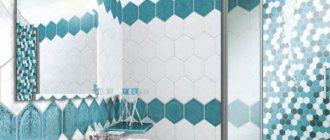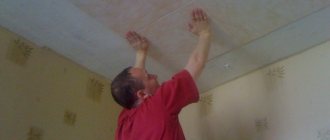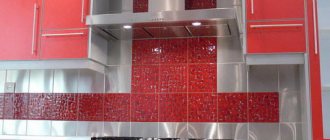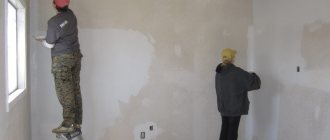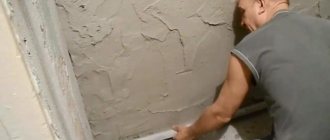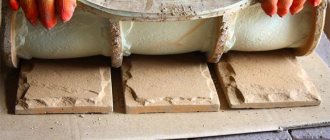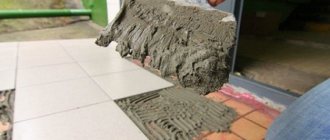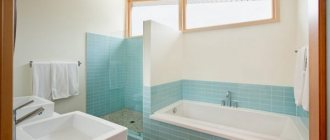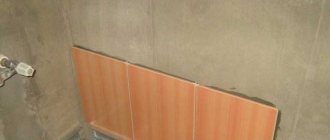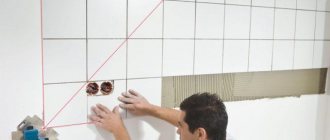Causes of destruction of masonry
First you need to determine why the ceramic tiles are coming away from the adhesive. There are a huge number of reasons for this defect. Let's look at the main reasons for tiles peeling off the wall and floor:
- Emptiness. If, during installation of the tiles or after drying, voids have formed in the structure of the adhesive layer and their area is more than 10% with local accumulation, the tile will most likely fall off.
- Violation of technology. To maximize the service life of the coating, ceramic tiles must be laid according to a special technology, its requirements relate to temperature conditions and humidity levels, rules for applying glue, leveling, etc.
- Poor adhesion. If the base is not properly prepared or is represented by a specific material, it will not adhere to the glue and mortar.
- Uneven surface. This is especially true for tiles on the floor. The presence of serious differences in the height of the base leads to deformation and loosening of the cladding elements.
- Low quality glue. Using poor quality raw materials to produce the mixture and violating the proportions when mixing it worsens the final result.
- Insufficient layer of solution. Sometimes there simply isn't enough glue to secure the trim element.
- Excess glue. If there is a lot of solution, it may separate and crumble.
- Water penetration. Constant contact of the solution with water leads to its softening, which is why bathroom tiles often fall off.
- Strikes. If the tile is mechanically damaged or repair work is performed that involves contact with this surface, even from the opposite side, the mortar becomes loose and breaks.
- Temperature changes. With a sudden change in conditions, a “shock” may occur, including cracking of the tile itself.
- Dynamic base. The wood content increases the dynamism of the base when humidity and temperature conditions change.
- Presence of contamination. Any material comes off the glue if there are particles of dust or greasy deposits.
- Huge pressure. Heavy furniture and high traffic are also the reasons why tiles move away from the wall or crack on the floor over time.
- Old masonry. Old tiles cannot be used indefinitely without repair; the masonry also gradually wears out.
- Shrinkage of the building. This is especially true for new buildings, when the surfaces have not yet taken their final position.
The tile may fall off due to a violation of the cladding technology
Reasons for tile peeling
The main reason why the tiles in the bathroom fell off or moved away from the base is violations of the installation technology:
- There are voids left in the glue layer. If the total area of such voids is 15% or more, the risk that the tiles will fall off over time increases.
- The adhesive mixture was applied too thin or thick. The optimal layer thickness is indicated by the manufacturer.
- Using low-quality glue. Dry mixtures have a limited shelf life, after which it is not recommended to use them. Also, do not use mixtures that have absorbed moisture and formed lumps.
- Failure to comply with proportions when preparing glue. The recommended amount of water for mixing the dry mixture differs from each manufacturer, so before mixing the solution you need to read the instructions.
- The base was not treated with a primer, as a result of which adhesion to the base was insufficient. This happens especially often when laying tiles on concrete and plastered bases that have not been dust-free.
- Failure to comply with the temperature conditions during laying of tiles, as well as during the process of setting and drying of the glue. During the work and when the glue dries, the temperature in the room must be maintained at least +10 °C and there should be no drafts.
- Weak foundation. For example, laying directly on paint or whitewash.
- Mismatch between glue and base. For example, a wooden base requires special highly elastic compounds.
In addition to non-compliance with the basic rules when finishing a bathroom with tiles, the finishing can collapse for other reasons:
- Shrinkage of a building (wooden house or new building).
- Sudden and significant changes in room temperature.
- Mechanical load on the cladding: strong impacts, vibration.
Most often, the cladding comes off or falls off from the base due to poor installation.
Way out of this situation
What should you do if a tile falls off? Glue the tile back! Of course, there are many conditions under which this is not possible, for example, the poor condition of the ceramics. However, in most cases the product is suitable for further use. Therefore, to restore the interior, it is necessary to thoroughly clean the surface where the tiles were attached. Then apply the adhesive and glue the product to the appropriate place.
This method is only applicable to tiles that are in excellent condition, otherwise they will need to be replaced. Although a nuisance may occur in the form of a missing element. Then you can play with contrast or add bright colors to the overall design. To do this, you should purchase several ceramic products and replace them with outdated tiles, which will significantly refresh the bathroom.
If for some reason it is impossible to glue the tiles or pick out others, then it is best to approach the problem in an original way. Try creating a mosaic design, i.e. crumble the ceramics, and then collect it and paste it into the old place, but already thoroughly crumbled. This procedure must be done carefully to eliminate the possibility of an unpresentable appearance.
To prevent repeated peeling, it is necessary to establish the cause of the defect and then eliminate it. In practice, this is relatively easy to achieve, but you still need to try. For example, voids can be identified by ordinary sound by tapping each element separately. Various irregularities are visible to the naked eye, as is crumbling mortar. The detected defective area will have to be remade conscientiously, otherwise problems cannot be avoided.
If a tile on the wall has fallen off - a solution to the problem - Blog Stroyremontiruy
There is no need to immediately calculate the cost of laying new material over the entire wall if part of the tile has fallen off, because you can fix the situation with your own hands.
There are several options for gluing ceramic (tile) tiles, and you can also use a temporary solution - combining tile material and wallpaper (paint). First, we need to establish the reasons for what happened so that it does not happen again in the future. The Stroyremontiruy blog offers a really useful Kerama Marazzi catalog on the Vendor Keramik website, where you can choose ceramic tiles from Egypt, the Czech Republic, Germany, Italy and other countries. The prices in the catalog are not outrageous, there are no complaints about the quality, and the choice of colors and textures will allow you to choose the material for both the bathroom and the kitchen. Vendor Keramik will help if the fallen tile can no longer be restored and new ones need to be laid. Now let's look at why tiles fall off and what are the chances of returning them to their rightful place.
Preparation for tiling work
After dismantling the tiles in the bathroom, including the floor tiles, it is recommended to waterproof the floor, which overlaps the walls, the overlap is from 20 to 30 cm. After that, the surface of the wall on which there is no waterproofing should be treated with a deep penetration primer. Then you need to check the floor level, determine the slope if there is a drain, and, if necessary, bring the floor to the desired level while maintaining the plane. The same applies to walls, only taking into account that large (more than 2 cm) areas are coated with tile adhesive.
After this, it is necessary to check the materials, their expiration date and quantity, so that the work is completed immediately, and not dispersed due to a lack of materials.
As for wooden houses and structures, the tiles are laid on special compounds such as elastic glue or liquid nails.
Making your own tile adhesive
Self-prepared raw materials for work are the key to quality repairs.
The first option of raw materials for which you will need:
- foam plastic blocks 20x20x20 mm;
- acetone.
Blocks are laid out on the back side of the tile, on all corners and in the middle, and acetone is carefully dripped on top. After a few seconds, the foam blocks begin to dissolve. The resulting solution firmly adheres the tiles to the wall.
For the second option for preparing the solution, you will need sand, cement, PVA glue, and water. The basis here is sand, it is taken in a fine fraction, purified.
Cement and sand are taken in a ratio of 1 to 3.
The tile solution is prepared before use and must be used within three hours. PVA glue is added after mixing bulk materials. Half a kilo of PVA is spent on a bucket of solution.
The solution is ready for use if it has reached a uniform consistency.
The negative side of this preparation is that all components must be purchased separately. This option is advisable if the components are available.
To improve the quality of your home solution, you can add components that improve its properties: liquid soap, oil paint, liquid glass.
Selection of the necessary tools and materials.
To work on tiles you don’t need as many tools as you might think:
- notched spatula, cap (10 cm) and regular (25 cm);
- a hammer with a rubber head (mallet);
- a pair of buckets (for solution and water);
- rags;
- paint brush;
- crosses and other fastening materials;
- fugue.
As for buying new tiles, it all depends on the budget, desire and safety of the previous tiles, which can be cleaned of glue. In any case, the old tile will have chips and cracks from falls or physical impacts, so it will have to be replaced. But restoring tile masonry is the same method, which is the same for both old tiles (provided they are cleaned) and new tiles.
The second thing that is required for purchasing materials is the adhesive component.
Adhesion to the surface also depends on its type; there are different types of adhesive components for different types of surface material.
- Bulk materials. Or ordinary tile adhesive. One of the most popular materials for this type of work. There are several varieties that differ in composition, affecting fixation and setting speed, frost resistance.
- Liquid Nails. Elastic, easy to use, quick option. But this type of material can be used to glue single fallen tiles, since it glues, but does not cover the surface with a protective layer.
- Mastics. Practically not used in civil engineering. They have high resistance to compression and deformation. They are used in the mining industry and industries with unstable seismic conditions.
- Cement mortar. Very high strength, low elasticity. Mainly used in outdoor applications, in floor tiles.
Don't miss: Connecting copper and aluminum wires: rules and methods
How and with what to glue ceramic tiles to concrete
When gluing tiles to concrete, craftsmen use both a paste-like type of glue and a dry mixture.
The first type with a thick consistency contains water; when it evaporates, the material adheres to the surface. This is an easier way of gluing.
The dry mixture contains cement and sand. It is used in various works and is considered more reliable than the ready-made mixture.
The following types of glue are used for laying on concrete:
- Universal. A popular option because it is multifunctional.
- Base. Used for cladding large slabs.
- Reinforced. Also used when working with large slabs, and when gluing peeled parts.
- Highly specialized. Suitable for work with high temperatures and humidity.
Surface preparation
Before gluing fallen tiles in the bathroom, you need to carefully prepare the surface. Otherwise, peeling of the wall finishing may occur again in the future.
- If the tile comes off in parts, then it is necessary to remove the remaining fragments from the wall. This can be done using a chisel. The remains must be broken off carefully so as not to damage adjacent fragments.
- Check the strength of the fastening of adjacent segments. To do this, press on the elements adjacent to the defective area. If there is displacement, you need to dismantle the cladding around the entire perimeter.
- Also, using a chisel or spatula, clean the area of the wall from old primer and glue.
- If you are installing the same tile, you need to clean off any remaining installation materials from its back side. If the layer of adhesive material is difficult to remove, use a grinder. In addition to mechanical stress, you can soak the finishing elements for 3–4 hours in warm water. Sand small irregularities with fine abrasive material.
- If there are any uneven spots on the wall, smooth them out with putty and leave them to dry for a day.
- Apply a coat of primer. To avoid the formation of mold and fungal deposits in the bathroom, the surface of the wall can be treated with a solution containing fungicides.
- For further installation of tiles in the bathroom, allow the prepared area to dry completely for 36 hours.
Tile restoration technology
Only consistent and thoughtful work will guarantee that the masonry fragments will be firmly fixed and will never fall off again.
What do professionals recommend on how to carry out cladding:
- The first step is surface preparation. If the tile is cracked, remove its remains with extreme caution, taking care not to damage nearby elements. To do this, use a chisel and a small spatula. The base is cleaned, eliminating the old adhesive composition. If the layer is thick, it is first softened with a solvent. Irregularities are removed using putty and degreased. You can make a millimeter screed on the floor to eliminate roughness.
- For better adhesion, the walls are treated with a primer. When using cement mass, the base is moistened with a small amount of water; for other products it must be completely dry.
- Next, make an adhesive gasket. The mixture is applied to the tiles, zigzags are formed with a spatula, which should sag when fixed and adjusted. This is necessary for better grip.
- The height accuracy is checked with a level, crosses are used to maintain the size of the seams, they can be removed only three hours after strengthening the fragment. When the tile is inserted into place, it is lightly tapped with a rubber mallet to shrink it.
- It is better to start grouting the joints every other day to allow the glue to completely harden. Half an hour after applying the mixture to the joints, begin smoothing with a rubber spatula and an ordinary household sponge. To eliminate all stains you will need three to four approaches.
You should measure in advance the area that will need to be covered and buy the appropriate amount of consumables.
Coating restoration
When the wall is completely prepared, you can begin finishing, having previously treated the surface with an antiseptic. The process of performing the work is quite simple if you follow the instructions:
- It is more convenient to apply the adhesive directly on the floor. It is important to use a sufficient amount of mortar, but not to coat the fragment with too thick a layer of glue, as this will cause the tile to stand out from the rest.
- After the fragment is pressed against the wall, you can lightly tap the tile with a hammer with a rubber nozzle. This will help the glue spread better.
- Excess adhesive is cleaned off, and the distance at the seams is fixed.
- As soon as the cladding has dried, a grout mixture is applied to the seams.
If there are no crosses for the seams, you can use regular matches.
Gluing tiles
Undamaged tiles can be easily mounted back onto the wall. And in order to subsequently prevent the finishing material from peeling off, it is worth considering the possible causes of this defect.
If the solution crumbles a lot after drying, then the reason is its low quality. You should not use this adhesive mixture again, so as not to encounter a similar problem again.
If the problem lies in the unevenness of the walls, then fixing the tiles in their place will eventually lead to the ceramics coming off again. It is best to carry out the repair work again, first leveling the surface.
Before starting finishing, it is recommended to check the adjacent tile elements, as they may also be damaged. In this case, the old part is removed, the adhesive material is removed from it, its remains are removed from the wall, and then the fragments are glued again.
The problem of falling tiles
Despite the strength of the tiled finish, there are situations when some of its elements peel off or begin to buckle. The problematic element is identified by simply tapping on its surface: the sound will not be dull and monolithic, but ringing and hollow. This type of problem can have different scales - the technology for eliminating the integrity of the coating depends on them. If we are talking about 2-3 peeled tiles, then you can simply put them in place using one of the methods below.
Peeled tiles
However, there are more serious situations when a whole row of tiles begins to fall off (usually this happens on the walls). This occurs because the individual tiles are attached to each other using grout. Therefore, as soon as at least one element peels off, it begins to loosen the parts adjacent to it. This explains the importance of promptly eliminating the problem even on one tile, otherwise the entire cladding will have to be renewed. In addition, loose tiles can fall down and break, damaging plumbing fixtures or flooring along the way.
Grouting joints
After the adhesive solution has dried (about a day), start grouting the joints. To do this, you will need moisture-resistant grout, matched to the color of the old joints, and a rubber spatula. After the grout has dried, thoroughly wipe the restored area with a damp sponge, then with a dry cloth.
Restoration and repair
We start with preparation, which includes: cleaning the surface of old material, tiles, and insulation. Using a spatula or a hammer drill with a spatula, we clean the surface of old glue or other materials, after which we go through the spatula again, cleaning the surface as much as possible. In cases where pebbles or part of the old adhesive composition still remain, some advise soaking in warm water, but the most effective method is still a hammer and carefully beating off the material.
It also happens that the glue or composition that the repairmen used is non-standard, and neither a hammer nor a hammer drill can remove it properly. More precisely, you can spend quite a lot of time on these areas. It would be more rational to use a turbine with a special disk, although a regular disk for concrete will do. But you should use it carefully so as not to damage unnecessary elements, such as wiring, pipes, or accidentally saw through the partition.
Almost all types of adhesive material are also removed, with the exception of special glue. For example, there was a case when, in Soviet times, tiles were glued with glue for helicopter blades. Of course, it was possible to dismantle it only with the help of acids, but the likelihood that you will come across such material is practically reduced to nothing.
After cleaning the glue to a smooth surface, you need to go over it with sandpaper, removing small elements. Once these steps are completed, we begin priming. It is recommended to use deep penetration primer to improve adhesion to the surface and create a protective film. Leave the composition for 24 hours, after which you can begin installation.
Cleaning old tiles in the bathroom from the composition is done carefully, with a spatula or turbine, the main thing is not to disturb the special relief of the tile and not to destroy the tile itself. It is sanded to remove residues with sandpaper, but you can also use a special attachment on the DShM (it is worth wearing safety glasses when working with this technology).
If the tile comes off again, it is better to contact a specialist.
Step-by-step installation:
- After making sure that the primer has set, we prepare the adhesive solution and tiles.
- Using a notched trowel, apply the solution to the tile and apply it under the comb. The layer thickness should be 3 - 4 mm.
- We lay out the first row in a circle (the lowest row) under the level and under the plane. The floor tiles should already be ready by this point, since we take the level from there.
- We insert crosses between the tiles, two in each slot, one should be closer to the top, the second closer to the floor.
- Leave for a day to set. This is necessary so that the tile does not float and maintains both its plane and level.
- After the time has passed (24 hours), we proceed to laying the remaining layers, but for greater quality it is not recommended to lay out more than 5 rows at a time, due to the fact that there is a risk that the row will float. This time we insert the crosses into the crosshairs.
- When all the material is laid, we pick out the crosses and start sealing the seams. To do this we need a fugue, a plastic spatula and damp rags. We get rid of fugue residues on the tiles using this rag immediately after application.
Don't miss: Carpet floors
If everything is done in compliance with technology and with high-quality materials, the tiles will last even longer than the shelf life of the materials.
Repair using a mirror
In the case where the area with collapsed cladding is at a height of 150–180 cm, you can glue a mirror, diversifying the interior:
- The section of the wall where the mirror will be glued is leveled with a layer of tile adhesive so that, compared to the level of the surviving cladding, a niche with a depth of 2–3 mm is obtained.
- After hardening, the adhesive base is rubbed with sandpaper until a smooth surface is obtained.
- Use a brush to sweep away the dust from the base, after which a primer based on liquid glass (2 parts) and water (5 parts) is applied.
- After the soil has dried, a mesh of silicone glue is applied to the back side of the mirror, cut to the size of the niche, and the mirror is pressed tightly, but without excessive effort, to the base. While the glue is setting, the mirror is additionally fixed to the tile using masking tape.
Advice! To make it more decorative, decorative molding or mosaic can be glued around the perimeter of the mirror.
How to glue the fallen part
To properly carry out the restoration, you need to purchase a high-quality adhesive composition.
Which glue to choose - criteria
A bathtub is a source of high humidity, so materials for its finishing require special attention.
The adhesive for fixing tiles must have the following properties:
- Moisture resistance. The glue should not be water-soluble and create a porous adhesion of surfaces. If the glue contains dispersed particles, they should be as small as possible.
- High degree of adhesion. Tile is a fairly heavy type of cladding, so installation materials must provide the maximum level of fixation.
- Elasticity of the connection. The hardened composition must resist the formation of microcracks and peeling as a result of surface deformation.
- Quality. When purchasing an adhesive component for bathroom work, carefully check the expiration dates, storage conditions and integrity of the packaging. Ready-made mixtures should not be stored at temperatures below 0⁰C.
A mixture of cement and sand
The solution can be prepared at home. PVA glue is added to the mixture of cement, sand and water to improve adhesion. The same solution can be used to pre-level the wall. The disadvantage is the possibility of violating the technology for preparing the composition. The universal mixture is compatible with all types of tiles, including floor tiles. The proportions of the components are determined by the brand of the product. Add 200 ml of PVA glue to 10 liters of the finished composition.
Mastic
Mastic is supplied in plastic buckets of different sizes. It is a ready-to-use adhesive composition. Before starting work, mix the mass thoroughly.
Laying tiles using mastic adhesive.
Adhesive compositions
Several types of glue are used to restore tile cladding. They are divided into 2 groups:
- Dry mixes. To prepare the adhesive, the powder is mixed with water, following the proportions specified in the instructions.
- Ready pastes. The products do not require adding water.
The adhesive composition is selected taking into account the type of tile:
- Cement mixtures. Used for gluing decorative elements of small and medium weight. Adhere well to concrete or brick bases.
- Dispersive for laying tiles on the floor or wall. Suitable for lightweight materials.
- Polyurethane. The elastic composition is used for installing tiles on any base.
- Epoxy. Used for decorating smooth surfaces: wood, ceramics, metal. The glue is resistant to moisture.
Polyurethane tile adhesive.
Liquid nails can be used to temporarily restore the integrity of the cladding.
The composition is applied pointwise to the underside of the tile. The edges are covered with solid lines.
Other solutions
When partially restoring ceramic cladding, it is allowed to use materials that have the properties of tile adhesive. These include:
- Silicone sealant. The product does not need to be diluted with water before use. The elastic composition protects the connections from moisture penetration. Sealant is used in cases where 2-3 tiles have fallen off.
- Dye. Used for gluing tiles onto a smooth base. To improve adhesion, it is given a thick consistency.
- Bitumen mastic. The viscosity of this substance allows it to be used for local repairs. The resin is impervious to moisture, but is sensitive to high temperatures.
Instructions for gluing ceramics at home
Edible dish glue is suitable for gluing ceramic products. To glue a broken ceramic cup, you need to follow the instructions:
- you need to start by collecting all the elements of the product;
- if you need to restore a cup that has previously been glued, then use a knife to remove the remnants of the old adhesive;
- wash all elements with dishwashing detergent, rinse and let the water drain;
- put the details together in order to visually evaluate the planned work process;
- treat joints with acetone;
- Apply a thin layer of heat-resistant dish glue to the gluing areas;
- leave the first layer to dry a little;
- apply another layer and gently but firmly press all the elements together;
- it is advisable to fix the product more reliably, for example, by wrapping it tightly with knitting threads;
- leave the cup in a cool, dry place for three days.
Finally
In the article, we discussed what to do if a favorite mug or a vase given by an old friend breaks. As you can see, repairing porcelain with your own hands is not a difficult task, the main thing is to choose the right glue and strictly follow the instructions. Thus, a figurine or part of a service will decorate the house for a long time.
If you were unable to understand all the nuances, we recommend watching a video lesson on restoring porcelain and ceramic products with your own hands:
Ceramic tiles have increased strength and improved aesthetics. The tiles must be glued with an adhesive composition, which will ensure strength and durability. Such mixtures are produced according to the characteristics of the cladding material.
How long will it last?
The service life of tiles that have been correctly laid is not limited by time. The service life of the coating is reduced if the installation technology is violated, if materials with an expired shelf life were used.
In order for the cladding to last as long as possible, it is necessary to avoid installation errors and distribute the adhesive evenly over the entire surface, thereby eliminating the possibility of voids forming and deformation of the coating.
If the tile cracks
The tile may crack due to mechanical stress on it. If the crack is small, it can be easily repaired with putty or grout. In case of significant damage, the fragment is completely dismantled and replaced with a new one.
- Dismantling begins with removing the old grout.
- If the cracked tile holds well on the base, several holes are drilled in it, then it is easily broken with a hammer.
- Small fragments of tiles are knocked out with a chisel.
- The old mixture is removed.
- Primer is applied to the base.
- A solution is applied to the back of the material, the fragment is pressed against the primed, dried base.
How to prevent peeling - quick tips
To avoid having to regularly carry out minor repairs to the bathtub, it is better to take measures that will allow the tiles to last as long as possible.
- When laying finishing materials, strictly follow the technology requirements. A minimal deviation from the instructions can lead to serious defects and rapid peeling of the cladding.
- Lay the tiles on carefully leveled and primed walls.
- For each type of wall (brick, concrete, wood, metal) there is a special adhesive composition that provides the greatest adhesion. Use mounting mixtures suitable for a particular type of surface.
- After installation is complete, treat the joints between walls and floors, as well as corners and protruding areas with waterproofing sealant.
How to glue tiles
The technology for laying tiles is simple. Main stages:
- Puttying. Used to increase the adhesion of glue to walls. To proceed to the next step, you must wait until it dries completely. Information about this can be found on the packaging.
- Layout. The stage at which parts are tried on and adjusted, and markings are made on the wall
- Searching for the horizon. Responsible moment. Using a building level, you need to draw a “starting” horizontal line on the wall. The lower it is located to the floor covering, the better.
- Applying glue. The composition is applied with a notched trowel. The width of the application is slightly greater than the height of one tile.
- Laying tiles. The tiles are applied piece by piece to the surface, slightly pressing. Compliance with geometry is checked using a building level. Crosses. They are used to achieve equal gaps between tiles over the entire surface.
Video review
Sources
- https://gidpoplitke.ru/remont-i-uhod/kak-prikleit-otvalivshuyusya-plitku.html
- https://sovety-vannoy.ru/delaem-remont/ukladka-plitki/otvalilas-plitka-v-vannoj-chem-prikleit.html
- https://stroy-podskazka.ru/nastennye-pokrytiya/plitka/chem-prikleit-v-vannoj/
- https://VseProKley.ru/vannaya/kak-prikleit-plitku-v-vannoj-na-stenu-esli-ona-otvalilas
- https://rebathroom.ru/otvalilas-plitka-v-vannoj-chem-prikleit.html
- https://OPlitke.com/montazh/chem-prikleit-plitku-v-vannoj-esli-ona-otvalilas
- https://MasteraVannoy.ru/plitka/chem-prikleit-esli-ona-otvalilas.html
- https://stroitelniportal.ru/svoimi-rukami/plitka/chem-prikleit-plitku-v-vannoj-esli-ona-otvalilas/
- https://plitkahelp.com/ukladka/chem-luchshe-prikleit-plitku-v-vannoj-esli-ona-otvalilas
- https://KraskaGuru.ru/klej/plitka/esli-otvalilas-v-vannoj.html
[collapse]
